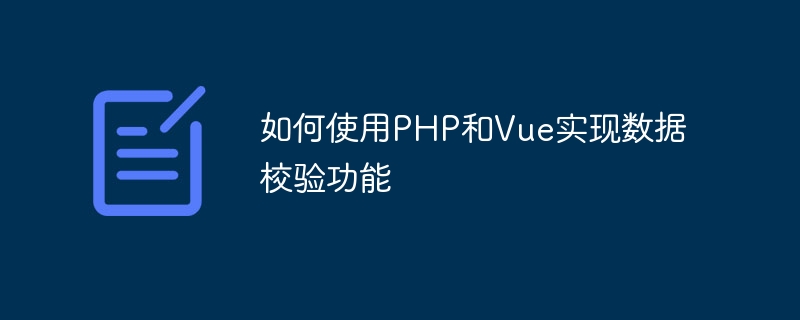

How to use PHP and Vue to implement data verification function
Introduction:
In web application development, data verification is a key step. Data validation ensures that user-entered data conforms to expected formats and rules, helping to improve data accuracy and application security. This article will introduce how to use PHP and Vue to implement data verification functions, and provide specific code examples.
1. Front-end data verification
<template>
<div>
<input v-model="inputValue" @input="validateInput" />
<div v-if="errorMessage">{{ errorMessage }}</div>
</div>
</template>
<script>
export default {
data() {
return {
inputValue: '',
errorMessage: ''
}
},
methods: {
validateInput() {
// 进行数据校验
if (this.inputValue.length < 6) {
this.errorMessage = '输入的内容不能少于6个字符'
} else {
this.errorMessage = ''
}
}
}
}
</script>In the above example, we bind the input box by using the v-model directive value to the inputValue property of the component. Every time the value of the input box changes, the @input event will trigger the validateInput method for data verification. If the entered content is less than 6 characters, a corresponding error message will be displayed.
<template>
<div>
<data-validation></data-validation>
<button @click="submitForm">提交</button>
</div>
</template>
<script>
import DataValidation from './DataValidation.vue'
export default {
components: {
DataValidation
},
methods: {
submitForm() {
// 在这里进行表单的提交逻辑
}
}
}
</script>In the above example, we introduced a component named DataValidation# by using the components option ##s component. Then, add the tag of the DataValidation component to the template where data verification is required.
<?php
$username = $_POST['username'];
$password = $_POST['password'];
if (empty($username) || empty($password)) {
echo '用户名和密码不能为空';
} elseif (strlen($username) < 6) {
echo '用户名不能少于6个字符';
} elseif (strlen($password) < 6) {
echo '密码不能少于6个字符';
} else {
// 数据校验通过,进行下一步的逻辑处理
}
?>username in the $_POST global variable and password value to perform data verification. According to the specific verification rules, we can use the empty function to check whether the value is empty, and the strlen function to check whether the length of the value meets the requirements.
<script>
export default {
methods: {
submitForm() {
axios.post('/api/submit-form', {
username: this.username,
password: this.password
})
.then(response => {
// 处理服务器端返回的数据
})
.catch(error => {
// 处理请求错误
});
}
}
}
</script> in JSON format. /api/submit-formInterface. The back-end PHP program can receive and process these data and perform corresponding data verification and other logical processing.
By using PHP and Vue to implement data verification functions, we can improve the data processing capabilities and security of web applications. The data verification component of Vue.js can be used on the front end to easily perform client data verification, while PHP can be used on the back end to further verify and process the data submitted by the client. The above is an introduction and code example on how to use PHP and Vue to implement data verification functions.
The above is the detailed content of How to use PHP and Vue to implement data verification function. For more information, please follow other related articles on the PHP Chinese website!




